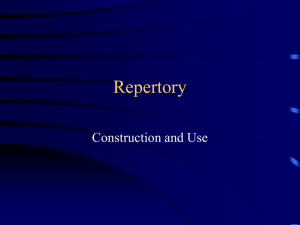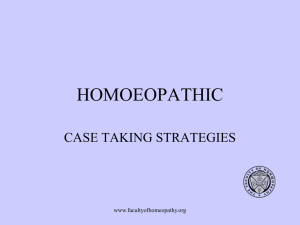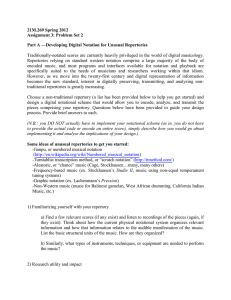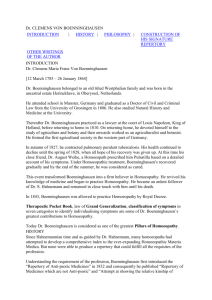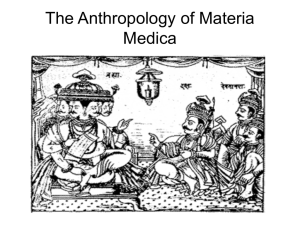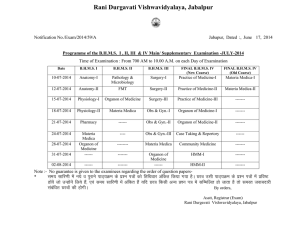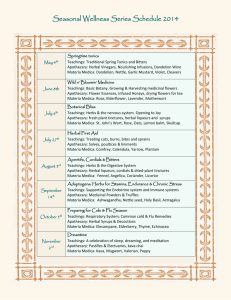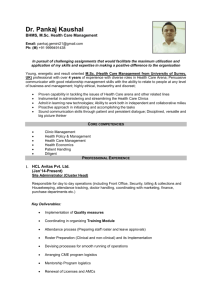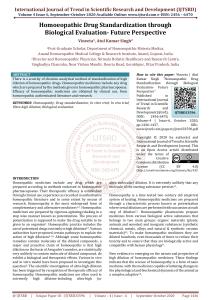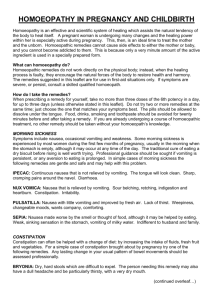Complete Repertory to Eye
advertisement
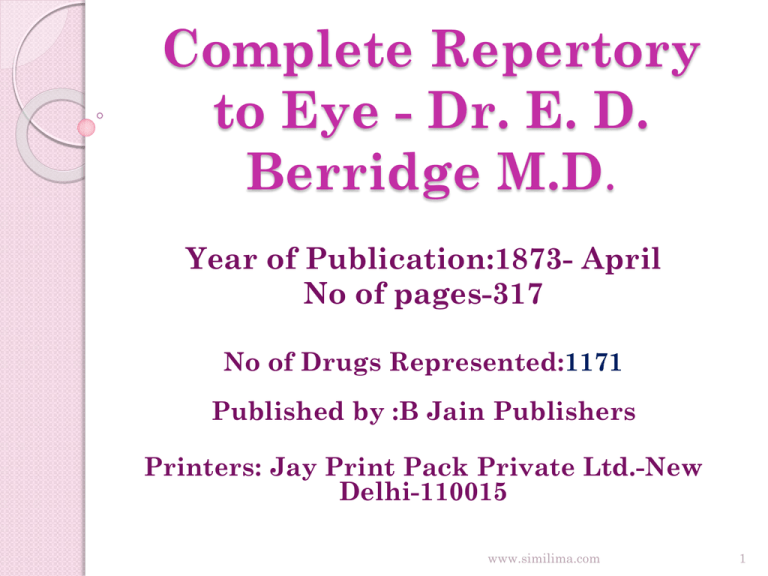
Complete Repertory to Eye - Dr. E. D. Berridge M.D. Year of Publication:1873- April No of pages-317 No of Drugs Represented:1171 Published by :B Jain Publishers Printers: Jay Print Pack Private Ltd.-New Delhi-110015 www.similima.com 1 Dr. (Mrs.) Arpana Pareek Reader, Dept Of Repertory Smt. KBAHMC, Chandwad www.similima.com 2 About the Author Bachelor of Medicine and Bachelor of Surgery from the University of London Doctor of Medicine from the Homoeopathic College of Pennsylvania Formerly Resident Medical Officer to the Liverpool Homoeopathic Dispensary www.similima.com 3 Author of Index to cases of poisoning in the allopathic journals Pathogenetic record www.similima.com 4 Contribution to American Journal of Homoeopathic Materia Medica North American Journal of Homoeopathy Hahnemannian Monthly Hering’s Complete Materia Medica Monthly Homoeopathic review Gregg’s Homoeopathic Quarterly British Journal of Homoeopathy etc. www.similima.com 5 Source The main basis of this repertory is C. Hering’s Materia Medica. Added some additional symptoms from later provings, valuable symptoms from cases of poisoning, reported in the Allopathic Journals, which will in due time appear in the “Pathogenetic Record,” now being published as an appendix to the British Journal of Homoeopathy. www.similima.com 6 INTRODUCTION The author gives importance to the clinical symptoms apart from the symptoms obtained from the provings. The author feels that it is often difficult or impossible to decide from the proving alone what symptoms are really connected with each other; whereas, if a group of symptoms is cured homoeopathically, there can be no doubt of the necessary connection of its constituents elements. www.similima.com 7 According to Dr. Berridge, if we wish to obtain maximum benefit from Homoeopathy , we can only do so by faithfully following the three great rules of the Master 1. Careful selection of Similimum 2. Single remedy 3. Minimum dose www.similima.com 8 Gradation of Rubrics 1. 2. 3. 4. 5. Italic capitals Plain capitals Italics Roman letters Roman (bracketed) – doubtful symptoms www.similima.com 9 The above typography is used mainly in relation to the rubrics and not to indicate the marks of medicines. The medicines are written either in roman or in roman parenthesis in the repertory part. www.similima.com 10 Cyphering With regard to the abbreviations of the names of the medicines, the author has adopted an uniform and scientific method of cyphering, as it is quite time that such absurd names as Hepar Sulphuris, Alcohol Sulphuris and c, be discarded for more scientific nomenclature. The cyphers of the elements and simple haloid salts are the same as their chemical symbols. www.similima.com 11 The –ate salts are cyphered by adding –a The –ite salts by adding –i to the cyphers of the corresponding haloid salt The –ic acids are cyphered by adding –x The –ous acids adding –ix The hydracids by adding –hx to the cypher of the element or compound radical from which they are formed. www.similima.com 12 Examples Na.= Sodium Na-s = Sulphide of sodium Na-sa = Sulphate of sodium Na-si = Sulphite of sodium S. = Sulphur S-x. = Sulphuric acid S-ix = Sulphurous acid S-hx = Sulphydric acid www.similima.com 13 In the medicines derived from the Animal and Vegetable kingdoms, each genus is invariably expressed by a different cypher. For Ex. rs – rhus toxicodendron rs-g –rhus glabrum rs-r -rhus radicans trg.- trigonocephalus lachesis trg-a - trigonocephalus atrox trg-c - trigonocephalus contortix www.similima.com 14 Plan and Construction A perfect repertory should contain a reference to every symptom of the Materia Medica under every rubric where it can possibly be looked for. To effect this he has divided each chapter of this repertory in 2 sections. 1. The symptoms & functions 2. Their conditions (including concomitants) www.similima.com 15 Section I Section I is further divided in to 5 sections a. Functional symptoms b. Anatomical regions c. General character , sequence and direction d. Right side e. Left side www.similima.com 16 a. Functional Symptoms Objects false appearance of (colors, far too, distorted, moving, multiplied, part visible) Objects, imaginary Photomania Photophobia Sight dazzled Sight impaired (Blindness, Dimness) www.similima.com 17 b. Anatomical Regions Eyeball Sclerotic Cornea Chambers of eyes Iris Lens Fundus Orbit www.similima.com 18 Orbital integuments Eyebrows Eyelids Puncta lachrymalis Canthi Carencula lachrymalis Lachymal gland Lachrymal bones Lachrymal sacs www.similima.com 19 c. General Character Sequence and direction Periodical Gradual increase and decrease Changing character or places Within-outwards Without – inwards Directions Alternate with other organs/Body www.similima.com 20 d. Right side- Gen Drugs affecting Right eye Functions Anatomical regions www.similima.com 21 e. Left Side- Gen Drugs affecting Left eye Functions Anatomical regions www.similima.com 22 Section II a. Aggravation b. Ameliorations All the symptoms in these subsections are arranged alphabetically, excepting the peculiar symptoms ,which not falling under any general heading are placed last All symptoms of a nearly identical meaning are placed under the same rubric, according to the table of synonym. www.similima.com 23 Aggravations 1. Time 2. Situation and external influences 3. Posture 4. Touch 5. Motion 6. Head 7. Mental factors 8. Eyes 9. Ears 10. Nose 11. Face and front of neck www.similima.com 24 12. Teeth 13. Mouth and throat 14. Abdomen (including stomach anus and all functional symptoms thereof 15. Urinary organs 16. Sexual organs 17. Chest and larynx 18. Back and nape of neck www.similima.com 25 19. Arms 20. Legs 21. Sleep 22. Fever (chill, heat, sweat) 23. Generalities (including skin, bones convulsions, other drugs etc.) The arrangement of symptoms in section II is in every respect exactly the same as that of section I www.similima.com 26 Ameliorations 1. 2. 3. 4. 5. 6. 7. 8. Situations Touch Motion Mental factors Head Eyes Nose Abdomen www.similima.com 27 Urinary organs 10. Chest 11. Sleep 12. Fever 13. Generalities 14. Appendix 9. www.similima.com 28 Scope 1. Regional repertories can be used in the study of Homoeopathic Therapeutics as well as Materia Medica. 2. They help to repertorize the following type of cases a) Cases lacking mental generals and physical general but rich with common symptoms b) Cases with clinical diagnosis c) Short cases with a few symptoms www.similima.com 29 3. They are used as quick reference books at the bed side 4. Regional repertories contain some rubrics, which are not found in other general repertories, therefore they can become a good companion in study of such rubrics 5. Regional repertories help us to find the most appropriate palliative medicines in incurable cases. www.similima.com 30 Limitations Being a regional repertory its use is limited to particular type of cases. They are mainly used for reference work not for a complete repertorisation Grading of drugs-not done Number of drugs less Abbreviation different from the commonly using repertories. www.similima.com 31
